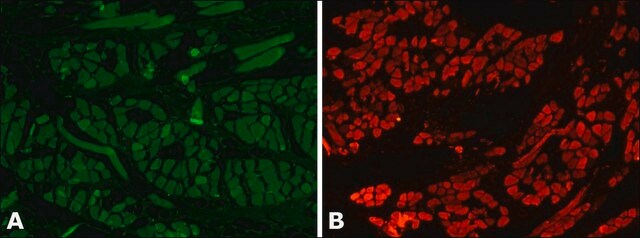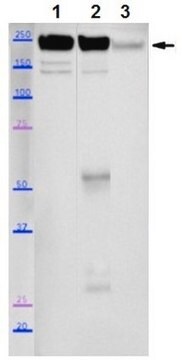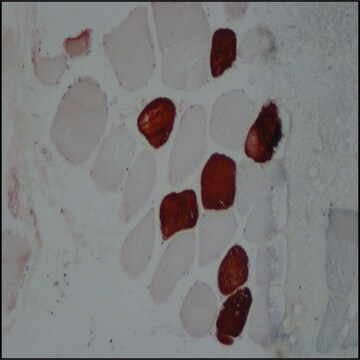Kluczowe dokumenty
M7523
Anti-Myosin (Skeletal) antibody produced in rabbit

whole antiserum
About This Item
IHC (p)
indirect immunofluorescence: 1:20 using human or animal sletetal muscle
Polecane produkty
pochodzenie biologiczne
rabbit
Poziom jakości
białko sprzężone
unconjugated
forma przeciwciała
whole antiserum
rodzaj przeciwciała
primary antibodies
klon
polyclonal
zawiera
15 mM sodium azide
reaktywność gatunkowa
human
rozszerzona walidacja
independent
Learn more about Antibody Enhanced Validation
metody
immunohistochemistry (formalin-fixed, paraffin-embedded sections): 1:20 using human or animal skeletal muscle
indirect immunofluorescence: 1:20 using human or animal sletetal muscle
numer dostępu UniProt
Warunki transportu
dry ice
temp. przechowywania
−20°C
docelowa modyfikacja potranslacyjna
unmodified
informacje o genach
human ... MYH13(8735) , MYH3(4621) , MYL1(4632)
Opis ogólny
Specyficzność
Immunogen
Zastosowanie
- immunohistochemistry
- immunostaining
- western blotting
- immunofluorescence
- immunolocalization
- immunocytochemistry
Immunocytochemistry (1 paper)
Western Blotting (1 paper)
Jakość
Oświadczenie o zrzeczeniu się odpowiedzialności
Nie możesz znaleźć właściwego produktu?
Wypróbuj nasz Narzędzie selektora produktów.
Kod klasy składowania
10 - Combustible liquids
Klasa zagrożenia wodnego (WGK)
nwg
Temperatura zapłonu (°F)
Not applicable
Temperatura zapłonu (°C)
Not applicable
Wybierz jedną z najnowszych wersji:
Masz już ten produkt?
Dokumenty związane z niedawno zakupionymi produktami zostały zamieszczone w Bibliotece dokumentów.
Klienci oglądali również te produkty
Nasz zespół naukowców ma doświadczenie we wszystkich obszarach badań, w tym w naukach przyrodniczych, materiałoznawstwie, syntezie chemicznej, chromatografii, analityce i wielu innych dziedzinach.
Skontaktuj się z zespołem ds. pomocy technicznej






